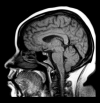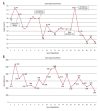Central Diabetes Insipidus in the Background of Lithium Use: Consider Central Causes Despite Nephrogenic as the Most Common
- PMID: 36683312
- PMCID: PMC9883600
- DOI: 10.12659/AJCR.939034
Central Diabetes Insipidus in the Background of Lithium Use: Consider Central Causes Despite Nephrogenic as the Most Common
Abstract
BACKGROUND Nephrogenic diabetes insipidus is a well-known adverse effect of lithium use. Albeit rare, there have also been documented cases of central diabetes insipidus (CDI) associated with lithium use. CASE REPORT A 31-year-old woman with a past medical history of bipolar disorder, managed with lithium 300 mg by mouth every day for 3 years, was assessed for a 1-year history of polyuria with accompanying polydipsia. During her initial hospital stay, her estimated urine output was more than 4 L per day. Initial labs showed elevated serum sodium (149 mmol/L; reference range 135-145), elevated serum osmolality (304 mOsm/kg; reference range 275-295), urine osmolality of 99 mOsm/kg (reference range 50-1200), and urine specific gravity (1.005; reference range 1.005-1.030). Lithium was at a subtherapeutic level of 0.05 mEq/L (reference range 0.6-1.2). Magnetic resonance imaging of the brain revealed no abnormalities of the pituitary gland. Two different occasions of desmopressin administration resulted in >50% increase in urine osmolality, confirming the diagnosis of CDI. Common causes of CDI, including trauma, tumors, and familial CDI, were ruled out and chronic lithium use was determined as the most probable cause for the patient's CDI. CONCLUSIONS CDI in the background of chronic lithium use is rarely reported. We present this case to consider CDI as a differential diagnosis when evaluating polyuria and hypernatremia in patients with long-term lithium use. These presentations warrant the consideration of both types of diabetes insipidus in the differential diagnoses.
Conflict of interest statement
Figures


Similar articles
-
A 75-Year-Old Woman with a 5-Year History of Controlled Type 2 Diabetes Mellitus Presenting with Polydipsia and Polyuria and a Diagnosis of Central Diabetes Insipidus.Am J Case Rep. 2022 Dec 31;23:e938482. doi: 10.12659/AJCR.938482. Am J Case Rep. 2022. PMID: 36585779 Free PMC article.
-
A COMBINED OUTPATIENT AND INPATIENT OVERNIGHT WATER DEPRIVATION TEST IS EFFECTIVE AND SAFE IN DIAGNOSING PATIENTS WITH POLYURIA-POLYDIPSIA SYNDROME.Endocr Pract. 2018 Nov;24(11):963-972. doi: 10.4158/EP-2018-0238. Epub 2018 Aug 14. Endocr Pract. 2018. PMID: 30106630
-
Congenital nephrogenic diabetes insipidus accompanied with central nephrogenic diabetes secondary to pituitary surgery -a case report.BMC Endocr Disord. 2021 Apr 21;21(1):78. doi: 10.1186/s12902-021-00749-y. BMC Endocr Disord. 2021. PMID: 33882907 Free PMC article.
-
Permanent central diabetes insipidus after traumatic brain injury. Case report and literature review.Zh Vopr Neirokhir Im N N Burdenko. 2022;86(5):112-118. doi: 10.17116/neiro202286051112. Zh Vopr Neirokhir Im N N Burdenko. 2022. PMID: 36252201 Review. English, Russian.
-
Gestational diabetes insipidus: Diagnosis and management.Best Pract Res Clin Endocrinol Metab. 2020 Sep;34(5):101384. doi: 10.1016/j.beem.2020.101384. Epub 2020 Feb 27. Best Pract Res Clin Endocrinol Metab. 2020. PMID: 32205050 Review.
Cited by
-
Successful Treatment of Lithium-Induced Nephrogenic Diabetes Insipidus with Celecoxib: A Promising Therapeutic Option.Am J Case Rep. 2024 Apr 21;25:e943244. doi: 10.12659/AJCR.943244. Am J Case Rep. 2024. PMID: 38643357 Free PMC article.
-
Partial central diabetes insipidus during lithium use: A case report and literature review.PCN Rep. 2025 Aug 13;4(3):e70182. doi: 10.1002/pcn5.70182. eCollection 2025 Sep. PCN Rep. 2025. PMID: 40821911 Free PMC article.
-
Lithium-induced nephrogenic diabetes insipidus following improved medication compliance: a case report.J Med Case Rep. 2025 Jan 23;19(1):31. doi: 10.1186/s13256-025-05034-3. J Med Case Rep. 2025. PMID: 39849643 Free PMC article.
-
Lithium Ions as Modulators of Complex Biological Processes: The Conundrum of Multiple Targets, Responsiveness and Non-Responsiveness, and the Potential to Prevent or Correct Dysregulation of Systems during Aging and in Disease.Biomolecules. 2024 Jul 25;14(8):905. doi: 10.3390/biom14080905. Biomolecules. 2024. PMID: 39199293 Free PMC article. Review.
References
-
- Hedya SA, Avula A, Swoboda HD. StatPearls. StatPearls Publishing; 2022. Lithium toxicity. https://www.ncbi.nlm.nih.gov/books/NBK499992/ - PubMed
-
- Boton R, Gaviria M, Batlle DC. Prevalence, pathogenesis, and treatment of renal dysfunction associated with chronic lithium therapy. Am J Kidney Dis. 1987;10(5):329–45. - PubMed
-
- Grünfeld J-P, Rossier BC. Lithium nephrotoxicity revisited. Nat Rev Nephrol. 2009;5(5):270–76. - PubMed
-
- Posner L, Mokrzycki MH. Transient central diabetes insipidus in the setting of underlying chronic nephrogenic diabetes insipidus associated with lithium use. Am J Nephrol. 1996;16(4):339–43. - PubMed
Publication types
MeSH terms
Substances
LinkOut - more resources
Full Text Sources
Medical
Miscellaneous

